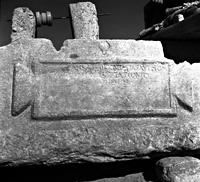 MAMA XI 318 (Perta)
MAMA XI 318 (Perta) 
Sarcophagus of Ba and parents
- Type of monument:
- Sarcophagus.
- Location:
- Hacınuman (Perta): built into a well.
- Description:
- Greyish-white marble sarcophagus; inscription in tabula ansata (Ht. 0.28; W. 0.81). Above, incised vase.
- Dimensions:
- Ht. 0.78; W. 2.10; Th. 1.10; letters 0.027-0.030.
- Record:
- Squeeze; MB notebook copy; photograph (1956/167).
- Publication:
- MAMA VIII 266.
- Date:
- Roman imperial period.
Βα ἡ καὶ Μίκκα Παπα ἑαυτῇ τὸν
〚λ̣ά̣ρ̣ν̣α̣κ̣α̣〛 μετὰ τῶν γο-
νέων.
Ba, also known as Mikka, daughter of Papas, (set up) the sarcophagus for herself, along with her parents.





Βα is an indigenous name characteristic of Lykaonia and Phrygia Paroreios (Zgusta 1964: 112 §131-1). The name Μίκκα, although left unaccented by the editors of MAMA VIII, is a relatively common Greek name meaning ‘small’ (MAMA XI 267 [1957/104: Laodikeia]; Robert 1963: 56-7; Zgusta 1964: 315 §916; Drew-Bear 1978: 108-9; BE 2009, 494). On the term λάρναξ, see Robert, Hellenica XIII, 239-45.
This sarcophagus was published in MAMA VIII with the provenance Giymir. ‘The villagers reported that this sarcophagus, complete with plain lid, had been excavated two years earlier, and contained a female skeleton with bracelet and bronze cross. The cross would suggest, without proving, Christianity; but doubt is cast on the report by two holes in the base, suggesting that the sarcophagus has been reused for some practical purpose’ (MAMA VIII 266). The vase incised above the tabula ansata could be taken to support the notion that Ba was Christian, if it is intended to depict a chalice: cf. MAMA XI 179 (1955/25: Synnada).